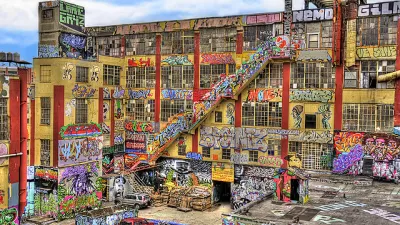After billionaire landlord Dan Gilbert commissioned a mural, less-legal works in Fairey's style began showing up around the city. Detroit's case against the artist brings gentrification's ironies into focus.

Detroit has moved to prosecute Shepard Fairey, the street artist behind "the much-imitated 'Hope' poster that came to symbolize Barack Obama's 2008 presidential campaign, and the 'Obey' series that features the enigmatic face of the wrestler Andre the Giant."
Invited to the city by Quicken Loans founder Dan Gilbert, Fairey "may not have been willing to color entirely within the lines. When he came to Detroit to do the job, several other works in his signature style showed up wheat-pasted around town [...] Now the city is prosecuting the artist on felony charges of malicious destruction of property, claiming that he caused as much as $30,000 in damage."
Fairey's arrest evokes a certain irony. Gentrifying developers "want neighborhoods to be 'colorful' and 'edgy,' with exciting 'street culture' that draws younger consumers to spend dollars in cafes and bars and boutiques—and ultimately to settle down in pricy loft-style apartments, fattening the tax rolls."
But a disconnect remains between "municipal dreams of a city where artists drive economic growth in an orderly, controlled way, and the reality of how artists see the world—or how they want to be seen." Is street art okay in a city like Detroit? Does graffiti attract the "wrong" people—or the right ones? These questions remain unanswered.
FULL STORY: The Mainstream Appeal of Outlaw Street Art

Manufactured Crisis: Losing the Nation’s Largest Source of Unsubsidized Affordable Housing
Manufactured housing communities have long been an affordable housing option for millions of people living in the U.S., but that affordability is disappearing rapidly. How did we get here?

Americans May Be Stuck — But Why?
Americans are moving a lot less than they once did, and that is a problem. While Yoni Applebaum, in his highly-publicized article Stuck, gets the reasons badly wrong, it's still important to ask: why are we moving so much less than before?

Research Shows More Roads = More Driving
A national study shows, once again, that increasing road supply induces additional vehicle travel, particularly over the long run.

Concrete to Community: A Schoolyard Makeover in West Philly
With guidance from the Trust for Public Land, third graders at Overbrook Elementary are leading the redesign of their asphalt schoolyard into a vibrant green space, learning valuable skills and creating lasting community impact in the process.

Which US Rail Agencies Are Buying Zero-Emissions Trains?
U.S. rail agencies are slowly making the shift to zero-emissions trains, which can travel longer distances without refueling and reduce air pollution.

San Diego School District Approves Affordable Housing Plan
The district plans to build workforce housing for 10 percent of its employees in the next decade and explore other ways to contribute to housing development.
Urban Design for Planners 1: Software Tools
This six-course series explores essential urban design concepts using open source software and equips planners with the tools they need to participate fully in the urban design process.
Planning for Universal Design
Learn the tools for implementing Universal Design in planning regulations.
City of Moreno Valley
Institute for Housing and Urban Development Studies (IHS)
City of Grandview
Harvard GSD Executive Education
NYU Wagner Graduate School of Public Service
City of Cambridge, Maryland
Newport County Development Council: Connect Greater Newport





























